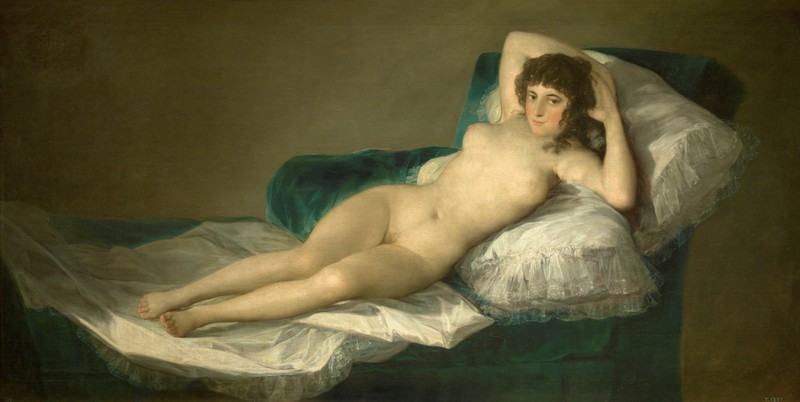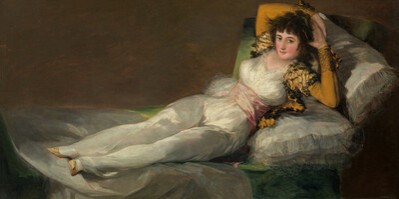- Cronología
- 1795 - 1800
- Ubicación
- The Prado National Museum. Madrid, Madrid, Spain
- Dimensiones
- 98 x 191 cm
- Técnica y soporte
- Oil on canvas
- Reconocimiento de la autoría de Goya
- Documented work
- Titular
- El Prado National Museum
- Ficha: realización/revisión
- 03 Feb 2010 / 14 Jun 2023
- Inventario
- (P00742)
This work formed part of Manuel Godoy's art collection. Following the Aranjuez uprising of 1808 and the abdication of King Charles IV that same year, the work was seized, along with other items, by order of Ferdinand VII. Between 1808 and 1813 it was stored, together with The Clothed Maja, at the Royal Academy of Fine Arts of San Fernando and in 1813 it was confiscated by the Inquisition. It was kept at the Madrid academy from 1836 until 1901, when it entered the collection of the Prado Museum, being mentioned in the museum's catalogue for the first time in 1910.
The first reference we have to The Nude Maja dates back to 1800, when it is mentioned as being in Manuel Godoy's palace, where it was hung above a doorway. No mention is made of The Clothed Maja, however, suggesting that at that time it had not yet been painted. In 1808 the present work appears once more in the inventory that Fréderic Quilliet, an agent of Joseph Bonaparte, made of Godoy's estate.
The Nude Maja is paired with The Clothed Maja, since the two works were probably commissioned by Manuel Godoy, the prime minister of King Charles IV. This would not have been the first painting of a female nude in Godoy's collection. His private study also contained The Toilet of Venus (La Venus del Espejo) (1647-1651, National Gallery, London) by Velázquez, and a copy of another Venus by Titian.
The identity of the woman posing for Goya in this painting remains a mystery although it has been suggested that it could be either the Duchess of Alba or alternatively Pepita Tudó, Godoy's lover from 1797 onwards.
The theme of the female nude has few precedents in the history of Spanish art, perhaps because it was considered to be an obscene subject matter. One only has to consider that, whilst in the academies of the period it was relatively common to copy from nude male models, the nude female body was instead studied by looking at classical sculpture or existing paintings, and never from life.
This vision of the female anatomy that Goya depicts so freely in The Nude Maja resulted in the painter being investigated by the Inquisition. On 16 March 1815, the Secret Chamber of the Inquisition of Madrid ordered, in reference to the two majas, that "said Goya be brought before this tribunal so that he might recognize them and declare whether they are his work, for what reason he made them, by commission for whom, and what ends were intended". Unfortunately we do not know what happened in the course of this process nor do we have any evidence of the statements that Goya made, which would have served to shed some light on the episode.
The woman, entirely naked, is shown in the same position as in The Clothed Maja, reclining on a green divan covered by a white bedspread and pillows. According to Xavier de Salas, the two majas were not painted at the same time, owing, in part at least, to the technical differences between the two works. In his opinion, The Clothed Maja was painted after the nude. In reality, the explanation for these technical differences stems from the need Goya felt to tackle these two works according to different criteria. So as to enjoy rendering the fabrics in The Clothed Maja, the painter used looser, freer brushstrokes to better capture the different qualities of the materials that cover the woman's body. However, the anatomical representation of The Nude Maja resulted in the adoption of a more academic vision for the work, in which draughtsmanship took on greater importance.
When making this painting, Goya may have referred to works such as Velázquez's The Toilet of Venus, Titian's The Venus of Urbino (1538, Uffizi Gallery, Florence) or Venus with the Organist, by the same artist (Ca. 1550, Prado Museum, Madrid). He may even have seen Female Nude seen from Behind (Ca. 1739, Galleria Nazionale d'Arte Antica Palazzo Barberini, Rome) by Pierre-Hubert Subleyras (Saint-Gilles-du-Gard, 1699-Rome, 1749).
-
Goya 1900Ministerio de Instrucción Pública and Bellas ArtesMadrid1900consultant editors Aureliano de Beruete, Alejandro Ferrant, Marqués de Pidal and Ricardo Velázquez. May 1900cat. 9
-
Les chefs-d’œuvre du Musée du PradoMusée d’Art et d’HistoireGeneva1939consultant editors Fernando Álvarez de Sotomayor y Pedro Muguruza Otaño. From June to September 1939cat. 6
-
Goya and his timesThe Royal Academy of ArtsLondon1963cat. 66cat. 85
-
El arte de GoyaMuseo de Arte Occidental de TokioTokyo1971from 16th 1971 to January 23th 1972. Exhibited also at the Kyoto Municipal Museum of Art, January 29th to March 15th 1972.cat. 31
-
GoyaPalacio de PedralbesBarcelona1977from April 12th to June 30th 1977cat. 36
-
De El Greco a GoyaPalacio de Bellas ArtesMexico D.F.1978November-December 1978cat. 37
-
Goya in the Metropolitan Museum of ArtThe Metropolitan Museum of ArtNew York1995consultant editors Colta Ives and Susan Alyson Stein. From September 12th to December 31st 1995cat. 6
-
Realidad e imagen. Goya 1746 – 1828Museo de ZaragozaZaragoza1996consultant editor Federico Torralba Soriano. From October 3th to December 1st 1996cat. 43
-
Goya. 250 AniversarioMuseo Nacional del PradoMadrid1996consultant editor Juan J. Luna. From March 29th to June 2nd 1996cat. 94
-
Goya en tiempos de guerraMuseo Nacional del PradoMadrid2008consultant editor Manuela B. Mena Marqués, from April 14th to July 13th 2008cat. 9
-
Goya: Order and disorderMuseum of Fine ArtsBoston2014cat. 4
-
L'œuvre peint de Goya. 4 volsParís1928-1950p.107, cat. 389
-
Vie et ouvre de Francisco de GoyaParísOffice du livre1970p. 194, cat. 743
-
BarcelonaPolígrafa1970vol. I, p. 339, cat. 539
-
GoyaBarcelonaCarroggio S.A. de Ediciones1974pp. 76, 77, 82, 83 (il.), 188 cat. 340
-
Francisco de Goya, 4 vols.ZaragozaCaja de Ahorros de Zaragoza, Aragón y Rioja1980-1982vol. II, pp. 128 y 129
-
The companion of Velázquez and a source for Goya's Naked MajaLondon1986pp. 643-654
-
Goya. 250 AniversarioMadridMuseo del Prado1996p. 371.
-
Der Künstler als Kuppler: Goyas nackte und bekleidete Maja en Herding, K.: Aufklärung anstelle von Andacht: kulturwissenschaftliche Dimensionen bildender KunstFrankfurtLang1997pp. 27-33
-
Goya. Die Kunst der FreiheitMunichVerlag C. H. Beck2000pp. 69-72, il. 20
-
Los mundos de Goya (1746-1828)BarcelonaLunwerg2008pp. 171-173, ils. 104, 105
-
Goya: Order & DisorderBostonMuseum of Fine Arts Boston Publications2014pp. 20-21

